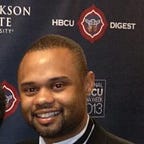[Letter to the Editor] What Happened to Saint Augustine’s University?
A real estate developer weighs in on the university’s sale of a historic, African American-owned golf club.
I read with interest the article on Saint Augustine’s University’s recent sale of the historic Meadowbrook Golf Course and Country Club to the Town of Garner, NC for the meager sum of $2.9 million. I was both dismayed and confused at such a short sighted decision on the part of the university.
Having worked in real estate development for over 35 plus years and specifically with a number of HBCU’s in facilitating the expansion of their real estate portfolio, I can’t imagine any circumstances in which an institution of higher education sells such a valuable asset at such an undervalued price.
The article suggests that Saint Augustine’s University made this decision because it is facing financial challenges that apparently cannot be addressed through increased enrollment or a short term line of credit. I am further confused by the financial state of affairs of the university at this time.
In January of 2014, former Saint Augustine’s University president Dr. Dianne Suber asked me to serve as a consultant to the university to aid in its effort to complete the football/track stadium that was under construction.
The track and playing field were in use, but the specific requirements for completion imposed by the City of Raleigh were proving to be more costly than anticipated.
In a smart financial move, SAU successfully refinanced a number of high interest bond debts that were generated long before Dr. Suber became president and had secured financing from the HBCU Capital Finance Program to purchase a residence hall that was being leased.
This action significantly reduced the university’s long term high interest debt and generated upwards of $450k into the university’s annual cash flow budget. The criteria of the HBCU Capital Finance Program, however, did not allow the university to use that source for completion of the stadium.
Part of my role was to coordinate with appraisers and environmental professionals to access the value of specific university’s real estate holdings, which is how I came to understand the value — both historically and financially — of Meadowbrook Golf Course and Country Club to the University.
Meadowbrook Golf Course and Country Club was founded by thirty African American men living in the Raleigh community in the late 1950s when no such facility was available to African Americans because of segregation. It consisted of 9 holes, a club house, sports shop, tennis courts, swimming pool and fishing lake.
When integration took its toll on its membership, and other golfing options became available to the African American community, the club fell into disrepair and the few living members and their offspring were unable to adequately maintain the property.
The decision was made to sell the property. There were several potential area buyers at the time, but the club members wanted to maintain the ownership in the African American community.
Dr. Suber approached then-SAU Trustee David Falk, Sr. of the firm Drucker and Falk, who agreed to purchase the property for the university, give the university full oversight of the property and, after an agreed period of time, gift the property to the university. At that time, the property had an estimated value of $3.2 million.
Saint Augustine’s invested around $50k to upgrade the greens, clean the picnic areas, restore the putt putt golf area, renovate bathrooms in the club house and refurbish the meeting room and porch area of the club house.
Meadowbrook is designated as a historic landmark by the North Carolina Historic Society. The university saw increased use of the course as it became an executive meeting site and a “lunchtime quickie” for area golfers.
The clubhouse hosted regular staff development training and other campus events on the site and families rented the space and grounds for reunions and birthday parties. The facility was generating income sufficient for its maintenance.
In 2014, I worked on behalf of the university to assemble a group of banking firms, potential donors and key stakeholders in developing a plan to finance the completion of the athletic facility. BB&T, a conservative banking institution by most standards, agreed to come to the table and to partner with the school in creating a substantial long-term financial relationship.
The members of the Bank’s team, at that time, considered Saint Augustine’s University creditworthy and financially stable. I was in the meetings when the representatives, having gone through the university’s financial records with a fine tooth comb, used the terms, “fiscally solvent;” “financially stable;” “stable enrollment,” “sound fiscal management;” and “consistent long term leadership” to describe why they found SAU to be a safe secure institution in which they were comfortable to invest.
What happened?
What has brought this institution to the brink of financial disaster so quickly that the possibility of selling the historic Meadowbrook Golf Course and Country Club would even be considered?
At the price of $2.9 million, it sort of feels like the proverbial “30 pieces of silver.”
Charles B. Gary is a real estate developer and project manager from Columbia, South Carolina. He is a graduate of Claflin University in Orangeburg, South Carolina.
